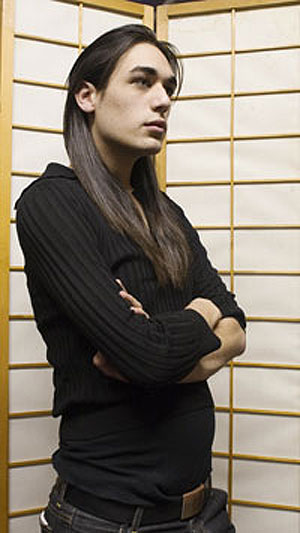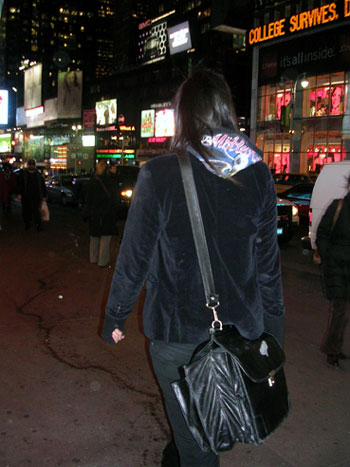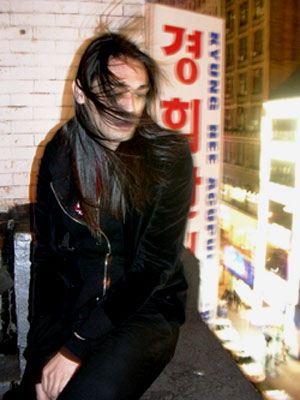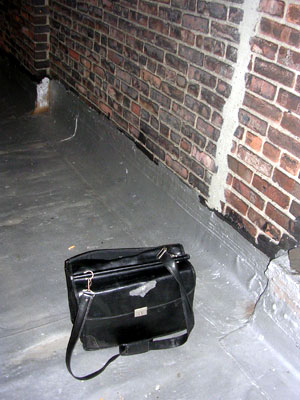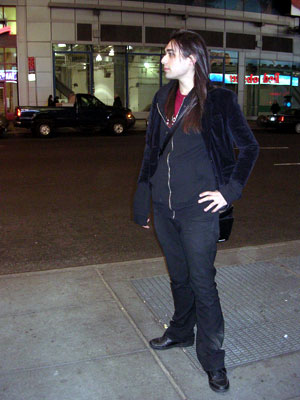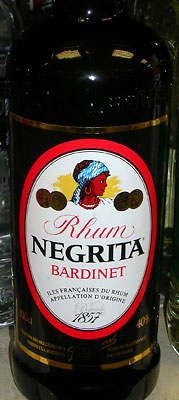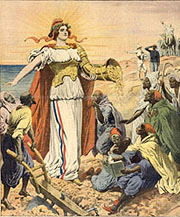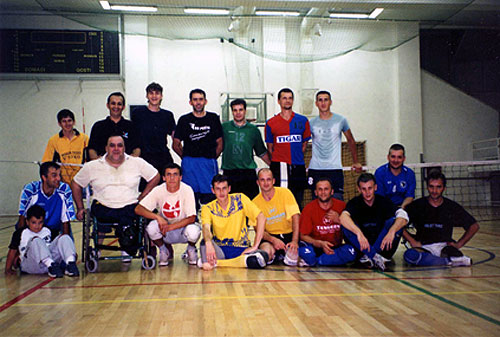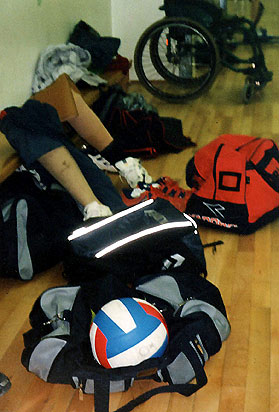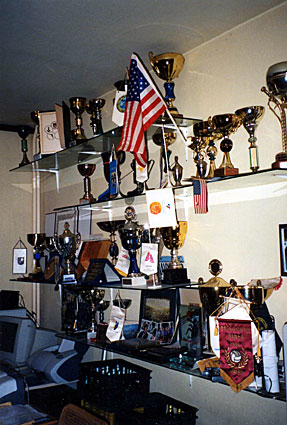
Hussain and his Fulbright fellows from all around the world visit a high school in Phoenix, Arizona, in February.
Hussain, like many of his compatriots, uses only his first name because he fears violence directed at himself or his family. For the same reason, he decided to stay at his university campus in Arkansas last January when the State Department invited him to meet President George W. Bush in Washington D.C. to mark Iraq’s first democratic election. “I don’t want to submit myself to death,” he says. “I am very recognizable in photos.” Hussain has heard enough about terrorists simply opening fire at people whom they identify as having gone to the United States or the United Kingdom.
Compared with the first group of Iraqis who were granted Fulbright scholarships in 2004 to study in the U.S. after 14 years of interruption — all met President Bush and Colin Powell at a White House reception their first year — only a handful of people in the second group showed up to the latest meeting with the president last January. Hussain said most of them come from southern and northern Iraq, where it is safer.
The State Department blamed limited attendance on short notice and said that not all current Iraqi Fulbright recipients — 34 of them — were invited to the informal event. However, according to some of the Iraqi intellectuals, many stayed home either in fear for their lives or to avoid the tormenting questions about the conflict taking place in their motherland.
The Fulbright scholarship is a cornerstone of U.S. public diplomacy, credited with forming a network of leaders around the world that are knowledgeable about, and sympathetic to, the U.S. government. But for many current Iraqi students — men and women ranging in age from their mid-20s to their late-40s — studying subjects such as public health, journalism, international affairs, and English at top American universities, the award is also a bit of a curse. Years of embargo make studying in an American university a lifetime opportunity for ambitious young Iraqis looking to obtain the education they need to help rebuild their country (Fulbright requires grantees to leave the U.S. after studying). But an association with the U.S. could also mean death for them and members of their family.
Although all of them seem uniformly happy that Saddam Hussein is no longer in power, they are painfully watching the news from home for signs of civil war. And many blame unfair, insensitive, and poorly designed American policies for the clashes among Sunnis and Shiites and the way post-dictatorship democracy in Iraq seems to be going awry.
Worry and wait
It was hard for Dr. Ali Fadhil, a 29-year-old medical doctor turned filmmaker who is studying journalism at New York University, to shake his mind of the image of American soldiers after he arrived in New York City in January. His three-year-old daughter runs to grab him in fear whenever a garbage truck stops outside their apartment in Brooklyn. The sound from the truck is similar to that of the explosives that U.S. troops used to shatter the door to his Baghdad house in January. Soldiers mistakenly suspected the award-winning filmmaker was involved in the abduction of the American journalist Jill Carroll. “I know that people on the streets here are different from the U.S. army in Baghdad,” he says. But it seems he has to keep reminding himself of that fact.
Tucked away in America’s most elite campuses, Iraqi scholars remain safe for now. But with grim thoughts and the shadow of omnipresent danger looming larger in their lives, the biggest group of Iraqi Fulbright students still call each other to share feelings of warmth and worry. They place phone calls from New York to Philadelphia, Kansas to Ohio, anytime they hear about a bombing at home to make sure their families are safe. Last year, a brother of a Fulbrighter was killed by insurgents.
Mohamed, a Fulbright scholar from Baghdad who is studying in Kansas, is worried because his elder brother wants to continue working as a policeman, even though he was shot and seriously wounded by insurgents last November. “He wants to show them that he is not afraid. But I don’t want him to do that. The situation is too dangerous now.”
With three of his children in Baghdad, another student, Hussain, feels sad when he imagines them seeing corpses on the sidewalks on their way to school. He observes that many Iraqi women now wear a veil because of threats made by fanatical groups, a precaution that they never had to take during Saddam’s regime. Friends at home tell him that the number of flies and sandstorms have increased rapidly in Baghdad due to the deteriorating environment.
However, Hussain doesn’t have any hatred toward the U.S. “I feel sad, the same way when I hear either Iraqi people or American[s] die,” says the 46-year-old with a salt-and-pepper beard. His sunburnt face has a look of calmness and wisdom. “I hate violence. I hate war. I love all people to live, not to die. I understand the American army as a tool to manipulate the policies designed by politicians here in the White House.”
Questions for the president
Hussain doesn’t hate Bush. “Bush is good [for his country]. He attracts terrorists from all over the world to Iraq in order to make them forget about attacking America. Iraq becomes a battlefield for terrorists.” The master’s degree candidate in comparative literature at the University of Arkansas says Iraq is a laboratory for the Americans to study terrorism. He expects the war to end in six to eight years. “The U.S. opens Iraq’s borders intentionally. All extremists in the world can go to Iraq to join terrorist cells without any papers.” He said the American army is well shielded, so few of them have been killed. But the Iraqi people are not shielded and Iraq is bleeding. “About 15 Iraqis die every day. Why should war exist in Iraq?”
Dr. Fadhil says he would love to meet the president. “I would thank Mr. Bush for removing Saddam; at the end this is the only major achievement that all Iraqis agree on,” said the filmmaker, who became a journalist by chance when a Guardian reporter asked him to work as a translator in 2003. “But it is not worth it for hundred[s of] thousands of Iraqis to die. We got nothing after Saddam — no jobs, no security, and no better life.”
Fadhil was chosen the U.K. Foreign Press Association’s Young Journalist of the Year in 2005 for his coverage of the Fallujah aftermath on Channel 4 news, which the association said “was the first independent witness account of the battle and questioned the U.S. military’s claim that the city was getting back to normal by confirming that no aid agencies were operating inside the city. His footage shows images of bodies rotting in the streets, open sewers, and refugees living in tents.” He would like to ask President Bush ten questions from “ordinary Iraqis who had their homes destroyed by the U.S. troops, and people who lost their beloved ones for the sake of the so-called democracy that is not there in Iraq now.” He would like to ask what President Bush thinks about the fact that human lives in the “shredded” Iraq are so cheap, except those of Americans and top officials.
Another Fulbrighter from Baghdad, who declines to be named, says, “I hate when the Americans say that they are shifting the anti-terrorism battlefield to Iraq. It really pisses me off. This is the city where I live. Why is there terrorism in my city? They didn’t think about me or about my people when they declared that. Who gave them this authority?” He laments, “Don’t they think of [the] 25 millions people living there, who are killed and being killed everyday? Nobody cares for Iraqi civilians.”
Open borders
Hussain and Mohamed believe that fanatic Islamism has come through the borders, brought in by foreign fighters. They say that border security is miserable and that people can easily transport money and weapons to support terrorists into or out of Iraq.
Hussain said that Iraqis would not plan suicide bombings or kill their neighbors, and cites the fact that terrorism was brought to Iraq after the war, not under Saddam Hussein. More proof is that three months after the war, Iraq was stable, apart from theft, robbery, and kidnapping “which have nothing to do with terrorism,” before the terrorists infiltrated Iraq.
He said that some Iraqi people — most of them former Baath and intelligence members who lost the benefits they had under Saddam — are helping the foreign fighters. Hussain blames it on the American decision to dissolve the former Iraqi army. “This is one of the biggest mistakes made by the U.S. in Iraq,” he says, “These people are well-trained to protect Iraq and guard the borders. They lost their job[s] but need to feed their families. Foreign terrorists are clever enough to pay them good salaries and make use of them.”
Sectarian division strategy
Most Fulbrighters interviewed tend to think that the Americans trust people according to how much they endured under Saddam’s regime and that this creates further divisions between ethnic groups and sectarians.
“When the Americans first came to Iraq in 2003, most translators, subcontractors, or anyone closest to the Americans was Kurdish. They took the people who Saddam tortured most as their best allies. They did not trust all people. They did not know enough about Iraq,” said an Iraqi Fulbrighter from Baghdad who declined to be named.
“The U.S. is creating enemies day by day, not friends,” says Hussain. He and Ali believe that the malicious divisions in Iraq now are the result of the Americans’ sectarian division strategy. Ali describes the sight of many Sunnis waiting along the international highway to welcome American troops. But according to him, their attitude toward the U.S. cooled down after the Americans gave their support to the Shiites who held government power. “The Sunnis were close to the U.S., but now they are enemies because the U.S. supports the Shiites and the Kurds at the expense of the Sunnis. They consider Sunnis as supporters of Saddam,” says Hussain, “The Americans don’t know our country enough. They treated the sects of Iraq unfairly and wrongly.”
Dr. Fadhil suggests another reason for the chaotic situation in Iraq: 30 years of powerlessness and isolation from the outside world. “Iraqi people live[d] inside Saddam’s prison for many years and the Americans freed them, like opening a cage for the criminals,” said Fadhil. “Everyone wants to be on top of each other. Everyone is Saddam now.”
There is no consensus among Iraqi Fulbrighters on the subject of American troop withdrawal. Mohamed believes that American troops should stay. “If the U.S. troops pull out, the country will be controlled by fanatics and extremists. There is already a small-scale ‘civil war’ carried on by some armed groups against civilians from both sects,” he said.
But Dr. Fadhil thinks things will only improve after U.S. troops are gone. He sees the deadly drift of Iraq into a civil war as having already begun. “But yet it will cure Iraq afterward,” says Fadhil. With a Sunni father and a Shiite mother, Fadhil doesn’t believe that people from the two sects can continue to hate each other because they have been living with each other for thousands of years. “The civil war will upscale when the troops pull out. But the American cannot solve this malicious legacy. The only way to solve it is to let the Iraqi find [his] own way to get out of the manipulation.”
Understanding Iraq’s “own way” — its culture and history — is a problem for the American troops in Iraq, some of the Fulbrighters contend. Hussain says that Iraqis find it offensive when U.S. soldiers say “hey” to them, a greeting that in Iraq is used only to call animals. “More seriously is the way the U.S. army seems to have little regard for the life of Iraqi civilians. They kill civilians on the street,” he asserts, as a result of overreaction and fear of insurgency. “[America’s] tanks sometimes tread on civilian cars in traffic jams and the like,” says Hussain.
“Do you think Iraq is a primitive country?”
The sadness and tension in Hussain’s face temporarily disappears as he sips a glass of California red wine at a reception in Phoenix, organized by the U.S. State Department to introduce Iraqi scholars to America last February. The sky is clear, lighted by a full moon. The desert air is warm and comfortable, although the area hasn’t had a drop of rain for four months.
“What do you think of America?” asks his host, an American woman who is a member of Phoenix’s City Council. “I should not say anything because my judgments may be wrong now. I cannot judge other culture from my own cultural background. I should live more with American people before I can say anything,” Hussain replies. His face has a look of experience. “Do you think Iraq is a primitive country?” he asks. “No, no,” the woman responds in a hesitant, almost nervous, voice.
Hussain’s wide eyes present an expression of pain. “We are a civilized country. We have 500 registered scientists. One of them is working for NASA. We can build two-storey bridges, construct refineries and chemical plants, and the like.”
Hussain is angry about how the Western media portrays Iraq. “They do that to show the world that Iraq desperately needs the American help. But Iraq is full of energy. It can restructure the country on its own in a secure atmosphere.”
The feeling that American people are ignorant about Iraq motivates him to study translation. “Translation is a problem between cultures. I would like to learn how to convey meaning in all senses, helping [to] remove all cultural problems that stand between countries. I am happy to understand people from the other side and make my people understand them, too.”
After going home in 2007, he plans to work as an interpreter to help reduce misunderstandings between the Iraqis and Americans.
Hussain becomes sad when he thinks about his five-year-old son, Baqir. Every day, the boy with big brown eyes waits behind the wooden door to receive a banana from his father as usual. He waits for hours and hours until the sunlight dies over the window, the streets, and the Baghdad International Airport nearby. His mother is cooking in the kitchen. But Baqir wants to wait and eat with Hussain. Whenever his father calls, Baqir asks why he hasn’t come home for a long time even though he still talks to him on the phone like he is in his office. Hussain has not told his son where he is.
“If he knew, he would tell everybody that I am in America,” Hussain says with a sad voice, horrified to remember how his children were often asked in kindergarten if their parents ever said anything bad about Saddam Hussein. “The terrorists consider anyone who goes to America a traitor or a secret agent. They cannot wait for me to come home. They will kidnap my child and kill him.”
Although he misses his family very much, Hussain has a single entry visa, and cannot leave the U.S. until he finishes the two-year program. He was stunned when he found out that all Fulbrighters could bring family with them to the U.S. except Iraqis. Like most Iraqi Fulbrighters, Hussain prays at home and avoids Muslim mosques in America or events where he may be recognized by other Iraqis.
Although the Fulbright is often considered one of the most competitive and prestigious scholarships in many countries, only the Iraqi Minister where Hussain worked knows Hussain received it. He told his neighbors and colleagues that he would be studying in Canada “because Canada doesn’t send army to Iraq.” His friend, Mohamed, has told people he studies in Germany.
Now, as the situation at home deteriorates, Hussain tells family members to build a big steel gate to protect the house. He intends to cut short his studies to return to Iraq early, even though it may be dangerous if his status as a Fulbrighter is revealed.
The first five Iraqi Fulbrighters went home recently. “There is lots of reluctance to leave,” Hussain says, “Half of the Iraqi Fulbrighters may face death when they go home. Nobody likes to die. But we have to go back to change our country.”
For Dr. Fadhil, who plans to return to Iraq to continue filming after finishing his studies, death is not beyond his everyday expectation. He says he can imagine dying in the street in Iraq, because “holding a camera there is like holding a gun.”
At a Fulbright event in February in New York, two Iraqi scholars seemed happy to meet each other. But after a passionate conversation, one woman in traditional black dress, who is studying at Columbia University, left without giving her contact information to the other Iraqi woman from Baghdad. The fear is so deep that some Iraqis have kept strict anonymity, even among fellow scholars.
Hussain, for his part, cannot stop thinking about terrorism. “Terrorism could not be fought by arms, but by mind. We should convince the mind of people about love, peace, respect for all sects, religions through culture and education,” he said, “Iraqi people should be treated with love, not hostility.”
- Follow us on Twitter: @inthefray
- Comment on stories or like us on Facebook
- Subscribe to our free email newsletter
- Send us your writing, photography, or artwork
- Republish our Creative Commons-licensed content












